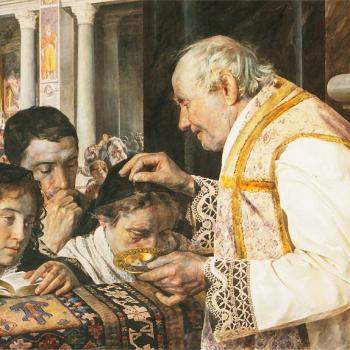Saints and Social Justice: A Guide to Changing the World, Brandon Vogt, Our Sunday Visitor Press, Huntington, 2014.
I came across this book when my parish selected it to be used by reading groups during Lent this year. As part of our Martin de Porres project on racism and the Catholic Church, we wanted a book that provided a broader discussion of Catholic social teaching which we could combine with a reading of the USCCB pastoral on racism in America, Open Wide Our Hearts (pdf). (For more on the MdP Project, see my video lecture on structural racism here.)
The author, Brandon Vogt, is a convert to Catholism. He works for Bishop Barron’s Word on Fire Catholic ministry, and is active on the Catholic blogging and speaking circuit. He has written several previous books. The book under review is intended as a gentle introduction to Catholic social teaching. The framework chosen by the author is to use the seven themes of CST adopted by the USCCB:
- Life and dignity of the human person
- Call to family, community and participation
- Rights and responsibilities
- Option for the poor and vulnerable
- The dignity of work and the rights of workers
- Solidarity
- Care for creation
For each theme he chose two saints (or blesseds, in three cases, and one servant of God) whose life and work, he believes, exemplify the theme. For instance, to illustrate life and dignity of the human person, he chose Blessed Teresa of Calcutta and St. Peter Claver (who worked with Black slaves in the New World). Each chapter gives a summary of the life of the saint, with an emphasis on those parts that he feels reflects the theme of CST. There are some boxed interludes with quotes from various other sources, such as the Catechism, and occasional episodes from the lives of other saints that also reflect the theme being considered. Finally, each chapter concludes with “lessons” that can be drawn from the life of the saint. These include specific attitudes and actions which can be emulated, and (in about 1/2 the chapters) some social actions the reader can take (such as supporting Catholic Relief Services or learning more about human trafficking.)
The book is an quick read, and the format makes it very easy to divide up into easily digestible chunks for a book group or adult religious education program. For an audience which knows little or nothing about Catholic social teaching or the lives of the saints, it provides a basic introduction to both.
However, even though I am going to be leading a parish book group using this book, I have some strong reservations about it. First, the book does not introduce the reader to the fundamental sources of the Catholic social teaching–the many papal encyclicals, starting with Rerum Novarum, that have laboriously developed it; the documents of Vatican II, particularly Gaudium et Spes, the Pastoral Constitution of the Church in the Modern World; and the documents from the USCCB and other bishops conferences. There are scattered quotes, but more often the book cites secondary sources, such as the Catechism, the Compendium of the Catholic Social Doctrine, or even the Youth Catechism (YouCat). Now, admittedly, these documents can be hard reading at times, and the author clearly wants the book to be accessible. However, I have read a papal encyclical with a group of Secular Franciscans (none of whom were academics), and with patience and a bit of guidance they were able to get a lot the document. I think there is a certain anti-intellectualism at work as well. In his introduction he writes:
Second, these teachings can often be abstract. They have great traction in ivory towers and among intellectuals, but they’re sometimes ignored by the ordinary Catholic looking for more practical spiritual advice. (p. 15)
The author would have done better to help is readers work through these texts: “practical” advice would be better served by being firmly grounded.
Second, while the idea of pairing saints with the themes of CST is an intriguing one in theory, it does not work as well in practice. The problem is bridging the gap between theory and practice. For instance, the two saints chosen to illustrate “care for creation”, St. Giles and St. Isidore the Farmer, have only a limited connection with the modern understanding of ecology and environmentalism, or with Pope Francis’s ideas about “integral ecology” (which in turn are grounded in earlier papal teaching about integral human development).
This framework, however, reflects a more fundamental problem with the book: it seems to me that the author either does not understand Catholic social teaching, or wants to downplay the “social” aspects to such a degree that it is reduced to acts of personal charity that grow out of Eucharistic piety. For instance, he mentions twice, in passing, that Blessed Pier Giorgio Frassati, was active in Catholic Action and in opposing the fascists (literally, the regime of Mussolini, which came to power two years before Frassati died). However, the vast majority of the chapter about Frassati is devoted to his personal acts of charity and to his piety. The reader, who presumably knows nothing about either Catholic Action or the rise of fascism, is not given any explanation for how Frassati’s actions were grounded in Catholic social teaching.
I am reminded of the wry comment from the Brazilian bishop, Dom Helder Camara, who said, “When I give bread to the poor, they call me a saint; when I ask why there are so many poor, they call me a communist.” Catholic social teaching, starting with Rerum Novarum, has asked deep questions about society and has not been afraid to criticize social structures (capitalist or communist) that fail to uphold human dignity. While recognizing the important role that individual acts of charity and justice play, CST also insists that there is a social dimension, and that social structures must be reshaped so that the promote the common good. This is a task that includes individuals, but larger social bodies, the government, and even transnational organizations (like the United Nations) must also play a role.
The author repeatedly fails to address this aspect of Catholic social teaching, and in fact, in a number of places, seems to reject it. For instance, he recounts the story of the time Dorothy Day, having received a diamond ring from a supporter, gives it to a poor woman who comes to the door. In her own writings, Day uses this story to illustrate the point that the poor deserve beauty in their lives, and not just the bare minimum they need for sustenance. The author, however, uses this incident to obliquely critique government action: Dorothy Day, he writes,
embraced the principle of subsidiarity, which says that decisions should be made at the lowest level possible. In this case, the lady receiving the ring should decide how to use it — not Dorothy, not her friends, and not the state. (p. 91)
This interpretation strains both the story itself and the principle of subsidiarity, which balances solidarity and shapes how social bodies (the state and “intermediate organizations”) should respond.
Similarly, the chapters on St. Peter Claver, Blessed Anne Marie Javouhey, and St. Roque González, feature saints whose work involved, the dark consequences of slavery, colonialism, and imperialism. St. Peter Claver worked with Black slaves arriving on slave transports in Colombia; Bl. Anne Marie worked in the British colony of Gambia and the French colony of French Guinea in the New World; St. Roque worked in the Jesuit Reducciones in Paraguay. In the case of Peter Claver the author does acknowledge the “supreme villainy” of the slave trade, but says nothing about slavery itself, or the racism that it spawned.
The life of St. Roque is a study in cognitive dissonance: on the same page (p. 57) he describes the saint’s father as a “bold adventurer who left Spain to conquer and colonize the New World”, and then two paragraphs later criticizes the conquistadors for their “lust for gold, land, and power.” The colonial administration (the so called encomienda system) is criticized, but the Jesuit response, which was to force the native population to leave their villages and live in mock European villages, is praised. There is no acknowledgement that the Spanish conquest was at all problematic. In am reminded of a private joke I shared with one of my friends, a Honduran who is a historian of Central America and the Caribbean. Whenever I wanted to yank his chain, I would ingenously praise the Spanish because they brought our ancestors “civilization and the true faith.”
Moreover, in the lives of each of these these saints the Black and indigenous populations they are helping are never treated as subjects–individuals with lives, identities, and intrinsic worth. Rather, they are objects who are there to be helped, and whose only autonomous action is to show “gratitude” to the saints who help them. For instance, when Blessed Anne Marie left French Guinea, the author recounts that
As her ship sailed away, bobbing canoes filled the surrounded the vessel, filled with free men and women saluting her and thanking her with song. (p. 53)
Now in each case these saints were thoroughly embedded in their own time and cultural milieu, and they cannot be held responsible for not fully recognizing or confronting the structures of sin that they were part of. The author, however, has no such excuse. Indeed, a significant contribution of Catholic social teaching has been to make clear the role of social structures in promoting evil and undermining human dignity, and the necessity of confronting these structures, even when we are part of them.
I believe that the author wanted, as he said,
to re-introduce this body of wisdom [CST] to a world that has forgotten, misundersood, or ignored it, by unveiling these teachings through the lives of the saints. (p. 15)
In the end, however, I believe that he has fallen short. He has approached Catholic social teaching through too narrow a perspective, reducing the broader questions about a just society to personal acts of charity. He is hampered by a hermeneutic of suspicion which leads him to claim (without explanation) that
The Church’s teachings on justice, charity, compassion, and peace have been hijacked and misrepresented over several years. (p. 15)
It is always dangerous for a reviewer to tell an author what he should have written, but in closing, I will say that I wish he had looked to the papal social encyclicals more closely for guidance in writing this book. In particular, here are Pope John XXIII’s reflections on teaching the lay faithful about Catholic social doctrine, which he regarded as “an integral part of the Christian conception of life” (Mater et Magistra 222):
No Christian education can be considered complete unless it covers every kind of obligation. It must therefore aim at implanting and fostering among the faithful an awareness of their duty to carry on their economic and social activities in a Christian manner.
The transition from theory to practice is of its very nature difficult; and it is especially so when one tries to reduce to concrete terms a social doctrine such as that of the Church. There are several reasons why this is so; among them We can mention man’s deep-rooted selfishness, the materialism in which modern society is steeped, and the difficulty of determining sometimes what precisely the demands of justice are in a given instance.
Consequently, a purely theoretical instruction in man’s social and economic obligations is inadequate. People must also be shown ways in which they can properly fulfill these obligations.
In Our view, therefore, formal instruction, to be successful, must be supplemented by the students’ active co-operation in their own training. They must gain an experimental knowledge of the subject, and that by their own positive action.
It is practice which makes perfect, even in such matters as the right use of liberty. Thus one learns Christian behavior in social and economic matters by actual Christian action in those fields. (Mater et Magistra, 228-232)













